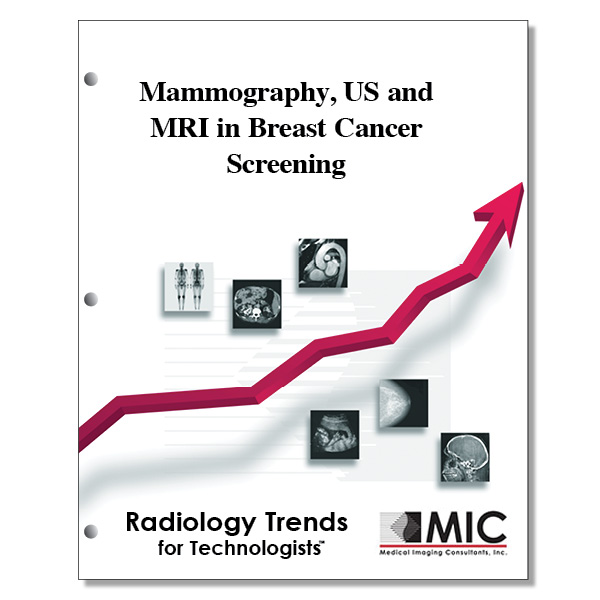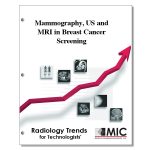

Mammography, US and MRI in Breast Cancer Screening
A review of the indications and efficacy of mammography, ultrasound and magnetic resonance imaging as both screening and diagnostic tools in the fight against breast cancer.
Course ID: Q00328 Category: Radiology Trends for Technologists Modalities: Mammography, MRI, Sonography2.5 |
Satisfaction Guarantee |
$29.00
- Targeted CE
- Outline
- Objectives
Targeted CE per ARRT’s Discipline, Category, and Subcategory classification:
[Note: Discipline-specific Targeted CE credits may be less than the total Category A credits approved for this course.]
Breast Sonography: 1.50
Patient Care: 1.00
Patient Interactions and Management: 1.00
Procedures: 0.50
Pathology: 0.50
Mammography: 2.00
Patient Care: 0.50
Patient Interactions and Management: 0.50
Procedures: 1.50
Anatomy, Physiology, and Pathology: 0.50
Mammographic Positioning, Special Needs, and Imaging Procedures: 1.00
Magnetic Resonance Imaging: 1.50
Patient Care: 0.50
Patient Interactions and Management: 0.50
Procedures: 1.00
Body: 1.00
Registered Radiologist Assistant: 2.00
Procedures: 2.00
Thoracic Section: 2.00
Sonography: 1.50
Patient Care: 0.50
Patient Interactions and Management: 0.50
Procedures: 1.00
Superficial Structures and Other Sonographic Procedures: 1.00
Radiation Therapy: 2.00
Patient Care: 1.50
Patient and Medical Record Management: 1.50
Procedures: 0.50
Treatment Sites and Tumors: 0.50
Outline
- Introduction
- Breast Cancer Screening
- Screening Mammography
- Breast US Screening
- Breast MRI Screening
- Imaging Features of Benign and Malignant Lesions
- Mammography
- Ultrasound
- Magnetic Resonance Imaging
- Problem Solving Using Mammography, Ultrasound, and MRI
- Abnormal Mammogram
- Preoperative Staging of Newly Diagnosed Breast Cancer
- MRI-Directed “Second-Look” US of the Breast
- Postoperative Breast
- Evaluation of Occult Breast Cancer
- Palpable Breast Masses and Pain
- Nipple Discharge
- Mastitis
- Evaluation of the Male Breast
- Unusual Findings
- Conclusions
Objectives
Upon completion of this course, students will:
- identify the most common cancer found in women
- recognize how much screening mammography has reduced mortality since the 1990s
- learn the factor most responsible for reducing the sensitivity of mammography
- know the recommended frequency of screening mammography
- realize that limitations with mammography have led to other developments in breast imaging
- understand attributes of ultrasound for breast imaging
- identify which patient population benefits most by adding ultrasound imaging to screening mammography
- know factors that cause women to be placed in a group of high-risk individuals for contracting breast cancer
- identify the imaging modality most sensitive for occult breast cancer detection in a high-risk population
- learn the sensitivity of the combination of screening mammography and breast MRI for the high-risk population
- understand how repeated radiation to the chest before age 40 affects breast cancer risk
- understand attributes of MRI for breast cancer screening
- recognize the characteristics of malignancy on mammography
- identify benign conditions that share mammographic features of malignancies
- realize the main diagnostic function of breast ultrasound
- know characteristics of cysts on ultrasound
- know characteristics of solid masses on ultrasound
- realize how a small, potentially malignant mass can be overlooked on ultrasound
- understand how benign US findings following a suspicious mammographic finding affects the course of action
- learn how to visualize breast cancer on MRI via dynamic contrast enhancement studies
- identify MRI pulse sequences used for dynamic contrast enhancement breast exams
- recognize dynamic contrast enhancement patterns on breast MRI exams and interpret what they mean
- learn about differentiating benign and malignant lesions with breast MRI
- realize the first course of action after a suspicious area is identified on a screening mammogram
- know what findings of coarse microcalcifications on ultrasound may indicate
- learn valid reasons to refer to breast MRI after an inconclusive mammogram
- know when ultrasound is beneficial in evaluating the extent of breast disease
- identify the most accurate imaging technique in the determination of the extent of breast disease in women with a new diagnosis of breast cancer
- realize why US-guided biopsy is often preferred over MRI-guided tissue sampling
- understand that “second look” US may not correlate with MRI breast lesion findings
- identify normal mammographic findings in a post-lumpectomy breast
- know what increased vascularity at the surgical site of a postoperative breast may be indicative of
- realize how patient age affects the course of evaluation when presented with breast pain or a palpable lump
- recognize the usual methods to evaluate nipple discharge
- know common causes for nipple discharge
- learn the best course of action to differentiate between mastitis and inflammatory breast disease
- know the percentage of breast cancer found in males
- recognize the usual diagnosis in the male referred for a mammogram
- identify common cancers that metastasize to the breast
- identify new technology being developed to improve early detection of breast cancer
